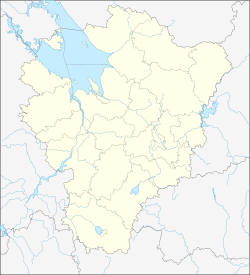Uglich
| city
Uglich
Углич
|
||||||||||||||||||||||||||||||||||||||||||
|
||||||||||||||||||||||||||||||||||||||||||
|
||||||||||||||||||||||||||||||||||||||||||
| List of cities in Russia | ||||||||||||||||||||||||||||||||||||||||||
Uglich ( Russian У́глич ) is a city in Russia in the Yaroslavl Oblast , with 34,507 inhabitants (as of October 14, 2010).
It is located on the upper reaches of the Volga and on the dam of the Uglich reservoir . From there it is - in each case as the crow flies - about 70 km north to the Rybinsk Reservoir and about 200 km south to Moscow .
history
Uglich was first mentioned in 937 and is one of the cities of the Golden Ring around Moscow . According to some historians, the name of the city comes from the Russian word ugol - corner - as the Volga makes a bend-like curve near the city.
During the time of the Mongol invasion of European Russia in the 13th century, the city was burned down and devastated several times. After 1450, Uglich had a supraregional importance as a trading center and also minted its own coins . Also in the 15th century, Prince Andrei had a Kremlin built in the city, a fortress surrounded by a wall and watchtowers, typical for old Russian cities.
After the death of Ivan the Terrible , his wife Maria and son Dmitri came to Uglich. There Dmitri died in 1591 under unknown circumstances. It is believed that regent Boris Godunov had him murdered in order to extinguish the Rurikid family and become tsar himself. On the spot where Dmitri died, the city built Demetrios Church in 1692. The Russian poet Alexander Pushkin took up this theme in his drama Boris Godunov .
In 1611 Uglich was devastated again, this time by the troops Pseudodimitri II. , Led by the Polish-Lithuanian Szlachcic Jan Piotr Sapieha . After the liberation of the city, it was able to record an economic boom as a trading town in the second half of the 17th century, and several stone church buildings were built in Uglich during this time.
Until the first half of the 20th century there was hardly any industry in Uglich and there was also no rail connection. It only began to develop here in the period after the October Revolution , after a hydropower plant was built near Uglich in the 1930s . However, several old church buildings and a monastery fell victim to the power plant construction. After the Second World War , a number of larger industrial objects were built in Uglich, including three mechanical engineering companies, a wood processing plant and a furniture factory.
In November 2008 a cable factory of the French company Nexans was put into operation.
In Uglich there was a prisoner of war camp 221 for German prisoners of war of World War II.
The German twin town of Uglich is Idstein im Taunus.
Population development
| year | Residents |
|---|---|
| 1897 | 9,698 |
| 1926 | 8,026 |
| 1939 | 12,282 |
| 1959 | 28,890 |
| 1970 | 35,463 |
| 1979 | 39,069 |
| 1989 | 39,975 |
| 2002 | 38,260 |
| 2010 | 34,507 |
Note: census data
Attractions
Some of the most famous buildings, besides the Uglich Kremlin, are the Monastery of the Protection and Intercession (1483) and the Cathedral of the Savior (1485). They both date from the city's heyday. Also of interest is the magnificent cathedral designed by the famous Russian architect Konstantin Thon .
Vodka is one of the most famous Russian products. A museum of the history of Russian vodka is located in Rostovskaya Street 1 in Uglich. In this small museum, vodka bottles from numerous licensed Russian vodka distilleries are displayed in glass cases. It is shown how the vodka is made and of course a tasting of the Uglich vodka is also included in a tour. Perhaps a mug of mead from Suzdal will also be served.
Next to the Vodka Museum is another small museum, the Museum of Prison Art.
Uglitschers seek relaxation in Victory Park. This is an amusement park. The two small museums are located at one of the entrances, near the Volga.
traffic
Uglich lies on the upper reaches of the Volga , which was made navigable on this section with the help of several barrages. One of the dams is in the city. The only road connection between the districts on the right and left of the Volga runs across the embankment. The city center with most of the historical buildings is located below the dam on the right bank of the Volga. The landing stage for the excursion boat is located here. Above the dam, also to the right of the Volga, is the freight port in an industrial area. Uglich has a branch line connection to the railway line from Moscow to Saint Petersburg via Pestowo . Uglich is connected to Russia's trunk road network by paved country roads to Yaroslavl (100 km), Rybinsk (85 km), Myshkin (40 km), Nekouz (60 km), Kalyasin (55 km) and Rostov Veliky (90 km). The direct road connections to Kashin (50 km) and Nagorje (80 km) are not paved throughout.
sons and daughters of the town
- Alexander Oparin (1894–1980), biochemist
- Vladimir Jakimow (1911–1989), politician (CPSU)
Individual evidence
- ↑ a b Itogi Vserossijskoj perepisi naselenija 2010 goda. Tom 1. Čislennostʹ i razmeščenie naselenija (Results of the All-Russian Census 2010. Volume 1. Number and distribution of the population). Tables 5 , pp. 12-209; 11 , pp. 312–979 (download from the website of the Federal Service for State Statistics of the Russian Federation)
- ↑ Maschke, Erich (Ed.): On the history of the German prisoners of war of the Second World War. Verlag Ernst and Werner Gieseking, Bielefeld 1962–1977.
Web links
- Unofficial web portal of the city (Russian)
- Sights in Uglich (pictures, information in German)
- Uglich in the Internet encyclopedia mojgorod.ru (Russian)






